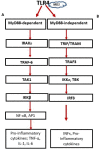Toll-Like Receptor 4 (TLR4) and AMPK Relevance in Cardiovascular Disease
- PMID: 36721803
- PMCID: PMC9871286
- DOI: 10.34172/apb.2023.004
Toll-Like Receptor 4 (TLR4) and AMPK Relevance in Cardiovascular Disease
Abstract
Toll-like receptors (TLRs) are essential receptors of the innate immune system, playing a significant role in cardiovascular diseases. TLR4, with the highest expression among TLRs in the heart, has been investigated extensively for its critical role in different myocardial inflammatory conditions. Studies suggest that inhibition of TLR4 signaling pathways reduces inflammatory responses and even prevents additional injuries to the already damaged myocardium. Recent research results have led to a hypothesis that there may be a relation between TLR4 expression and 5' adenosine monophosphate-activated protein kinase (AMPK) signaling in various inflammatory conditions, including cardiovascular diseases. AMPK, as a cellular energy sensor, has been reported to show anti-inflammatory effects in various models of inflammatory diseases. AMPK, in addition to its physiological acts in the heart, plays an essential role in myocardial ischemia and hypoxia by activating various energy production pathways. Herein we will discuss the role of TLR4 and AMPK in cardiovascular diseases and a possible relation between TLRs and AMPK as a novel therapeutic target. In our opinion, AMPK-related TLR modulators will find application in treating different immune-mediated inflammatory disorders, especially inflammatory cardiac diseases, and present an option that will be widely used in clinical practice in the future.
Keywords: AMPK; Cardiovascular disease; Inflammation; TLRs.
©2023 The Authors.
Conflict of interest statement
The authors declare that they have no competing interests.
Similar articles
-
Short-term treatment with metformin suppresses toll like receptors (TLRs) activity in isoproterenol-induced myocardial infarction in rat: are AMPK and TLRs connected?Int Immunopharmacol. 2012 Dec;14(4):785-91. doi: 10.1016/j.intimp.2012.10.014. Epub 2012 Oct 31. Int Immunopharmacol. 2012. PMID: 23122726
-
AMPK activation by metformin inhibits local innate immune responses in the isolated rat heart by suppression of TLR 4-related pathway.Int Immunopharmacol. 2016 Nov;40:501-507. doi: 10.1016/j.intimp.2016.10.002. Epub 2016 Oct 15. Int Immunopharmacol. 2016. PMID: 27756052
-
Role of Toll-like receptors and interferon regulatory factors in different experimental heart failure models of diverse etiology: IRF7 as novel cardiovascular stress-inducible factor.PLoS One. 2018 Mar 14;13(3):e0193844. doi: 10.1371/journal.pone.0193844. eCollection 2018. PLoS One. 2018. PMID: 29538462 Free PMC article.
-
Ischemia/reperfusion activates myocardial innate immune response: the key role of the toll-like receptor.Front Physiol. 2014 Dec 18;5:496. doi: 10.3389/fphys.2014.00496. eCollection 2014. Front Physiol. 2014. PMID: 25566092 Free PMC article. Review.
-
Toll-like receptor signaling: a critical modulator of cell survival and ischemic injury in the heart.Am J Physiol Heart Circ Physiol. 2009 Jan;296(1):H1-12. doi: 10.1152/ajpheart.00995.2008. Epub 2008 Nov 14. Am J Physiol Heart Circ Physiol. 2009. PMID: 19011041 Free PMC article. Review.
Cited by
-
Integrative analyses and validation of ferroptosis-related genes and mechanisms associated with cerebrovascular and cardiovascular ischemic diseases.BMC Genomics. 2023 Dec 4;24(1):731. doi: 10.1186/s12864-023-09829-w. BMC Genomics. 2023. PMID: 38049739 Free PMC article.
-
Insights into the Anti-Adipogenic and Anti-Inflammatory Potentialities of Probiotics against Obesity.Nutrients. 2024 Apr 30;16(9):1373. doi: 10.3390/nu16091373. Nutrients. 2024. PMID: 38732619 Free PMC article. Review.
-
The Role of Pattern Recognition Receptors in Epigenetic and Metabolic Reprogramming: Insights into Trained Immunity.J Inflamm Res. 2025 Jun 13;18:7795-7811. doi: 10.2147/JIR.S513325. eCollection 2025. J Inflamm Res. 2025. PMID: 40535352 Free PMC article. Review.
-
SARS-CoV-2 S protein activates NLRP3 inflammasome and deregulates coagulation factors in endothelial and immune cells.Cell Commun Signal. 2024 Jan 15;22(1):38. doi: 10.1186/s12964-023-01397-6. Cell Commun Signal. 2024. PMID: 38225643 Free PMC article.
-
Dioscin protects against chronic prostatitis through the TLR4/NF-κB pathway.Open Med (Wars). 2024 Sep 13;19(1):20241036. doi: 10.1515/med-2024-1036. eCollection 2024. Open Med (Wars). 2024. PMID: 39291282 Free PMC article.
References
Publication types
LinkOut - more resources
Full Text Sources



